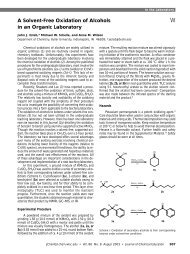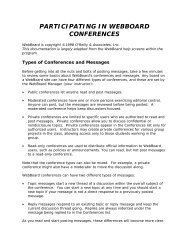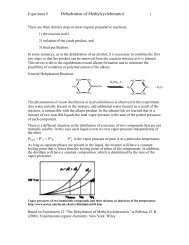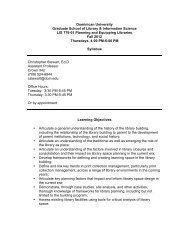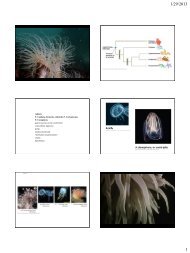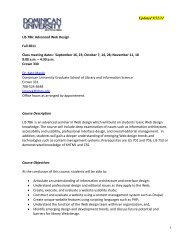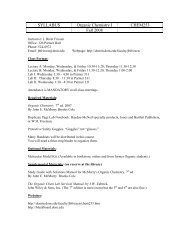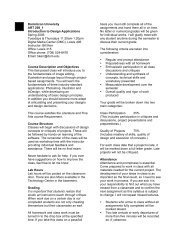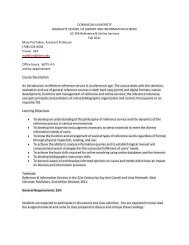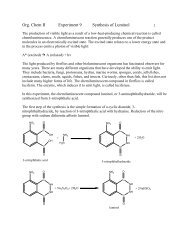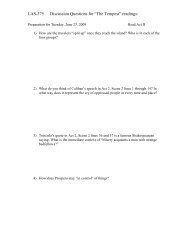Probability and Statistics
Probability and Statistics
Probability and Statistics
Create successful ePaper yourself
Turn your PDF publications into a flip-book with our unique Google optimized e-Paper software.
Biol. 240 <strong>Probability</strong> <strong>and</strong> <strong>Statistics</strong> Name_____________________<br />
As a student of genetics, you become interested in the phenotype of feathered<br />
legs in Black Langshan fowl <strong>and</strong> featherless legs found in Buff Rocks fowl. Your<br />
first inclination is that this trait is controlled by a single gene - two allele<br />
genetic system. To test this hypothesis you mate a true breeding Black Langshan<br />
with a true breeding Buff Rocks, <strong>and</strong> all of the offspring develop feathered<br />
legs. Reciprocal crosses yielded the same results.<br />
1. Using the letter, F, outline the proposed genotypes in this mating.<br />
After your first breeding experiment you become more convinced that you are<br />
dealing with a single locus system with one allele showing complete dominance<br />
over the other allele. Continuing the breeding study, you breed two of the F 1<br />
birds.<br />
2. Given your working hypothesis, what are the expected F 2 genotypes <strong>and</strong><br />
phenotypes in this cross?<br />
Upon performing the F 1 cross, the F 2 generation consists of 10 individuals, all<br />
of whom are feathered.<br />
3. Given the genetic system proposed above, what is the probability that all 10<br />
of the F 2 generation would be feathered? [HINT: What is the probability of a<br />
single F 2 individual being feathered? …the probability of 2? …of 3? …of all<br />
10?]
4. Which probability rule (Sum or Product?) did you use to answer this question?<br />
You explain the lack of any featherless individuals in the F 2 generation as<br />
"sampling error".<br />
5. What is meant by the phrase "sampling error?" [HINT: read next sentence]<br />
You increase your sample size by cross-mating several adults of the F 1<br />
generation. The F 2 generation now consists of 348 individuals.<br />
6. State your hypothesis for this experiment. (Given your working hypothesis,<br />
what F 2 ratio do you expect?)<br />
7. How many feathered <strong>and</strong> featherless individuals do you expect from this<br />
sample?
After the F 2 generation matures, you find that it consists of 325 feathered<br />
individuals <strong>and</strong> 23 featherless individuals.<br />
8. Calculate the chi-square value for your hypothesis. Show all calculations.<br />
9. Determine the degrees of freedom for this analysis.<br />
10. What probability value does your chi-square value give you?<br />
11. Does the analysis support or refute your hypothesis? Explain how this<br />
decision was made.<br />
12. Given that out of 348 F 2 individuals, 325 were feathered <strong>and</strong> 23 featherless,<br />
can you propose (in prose, not a ratio yet) an alternative hypothesis? [If a<br />
hypothesis with one gene, two alleles <strong>and</strong> complete dominance cannot explain<br />
these results, propose a two-gene model that could produce these F 2 proportions<br />
<strong>and</strong> yet still explain the F 1 results.]
13. What F 2 ratio does your new hypothesis predict?<br />
14. Calculate the expected phenotypic values.<br />
15. Calculate the chi-square value for your new hypothesis.<br />
16. Determine the probability level for your hypothesis.<br />
17. Does the analysis support or refute the hypothesis?<br />
18. Even if the preceding analysis supports your hypothesis, it does not prove<br />
your explanation is the correct one. Explain why?



